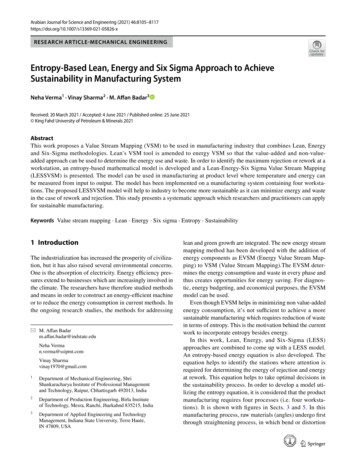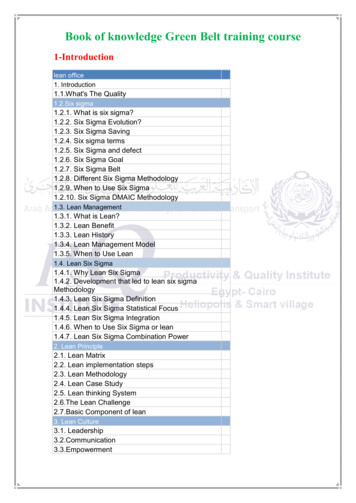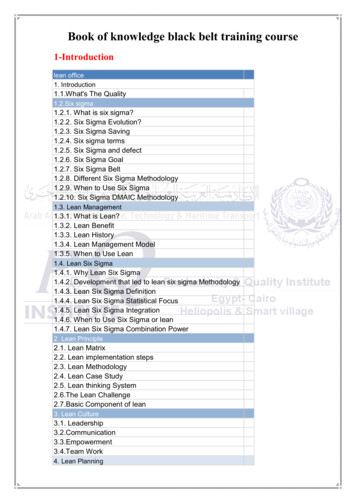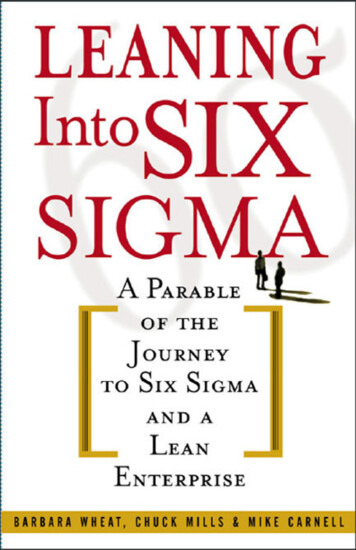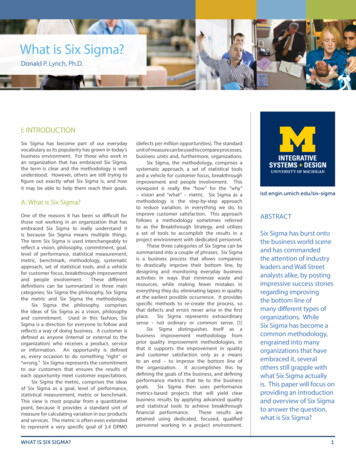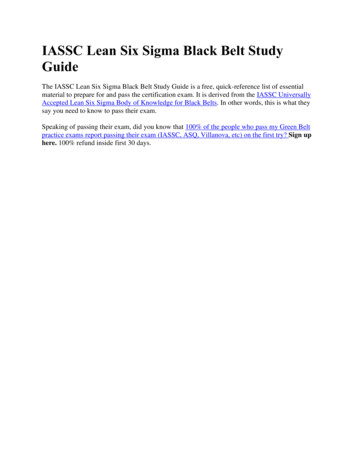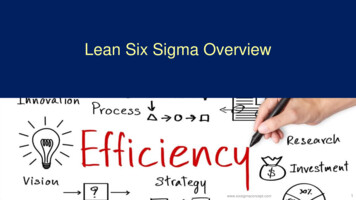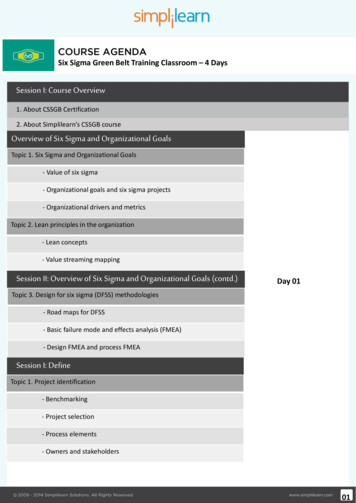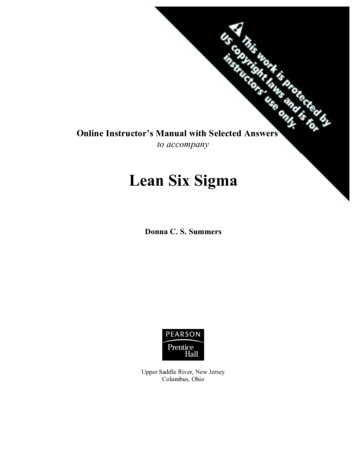
Transcription
Online Instructor’s Manual with Selected Answersto accompanyLean Six SigmaDonna C. S. SummersUpper Saddle River, New JerseyColumbus, Ohio
Copyright 2011 by Pearson Education, Inc., Upper Saddle River, New Jersey 07458.Pearson Prentice Hall. All rights reserved. Printed in the United States of America. This publication is protectedby Copyright and permission should be obtained from the publisher prior to any prohibited reproduction,storage in a retrieval system, or transmission in any form or by any means, electronic, mechanical,photocopying, recording, or likewise. For information regarding permission(s), write to: Rights and PermissionsDepartment.Pearson Prentice Hall is a trademark of Pearson Education, Inc.Pearson is a registered trademark of Pearson plcPrentice Hall is a registered trademark of Pearson Education, Inc.Instructors of classes using Summers, Lean Six Sigma, may reproduce material from the instructor’s manual forclassroom use.10 9 8 7 6 5 4 3 2 1ISBN-13: 978-0-13-512512-0ISBN-10:0-13-512512-X
Table of ContentsChapter 11Chapter 26Chapter 39Chapter 412Chapter 515Chapter 618Chapter 722Chapter 825Chapter 932Chapter 1039Chapter 1144Chapter 1247Chapter 1348Chapter 1451Chapter 1553Chapter 1658Chapter 1762Chapter 1867Chapter 1970Chapter 2077Chapter 2179Chapter 2282
Chapter 1 Questions1.1 Describe the goals of the lean methodology.Lean techniques seek to improve value-added process flow. Leanconcepts seek to reduce the waste present in processes and activities.This waste may be present in downtime, rework, waiting, or inspection.Lean techniques focus on finding and eliminating non-value addedactivities.1.2 What are the benefits of implementing lean?Lean tools and techniques are designed to improve process performance,improve quality and productivity, while reducing costs and enhancingprofitability. Companies implementing lean have reported significantreductions in cycle times, handling costs, lead times, floor space usage,inventory, and customer service activities. At the same time, they see asignificant improvement in quality, inventory turns, profit margins, andcustomer responsiveness.1.3 What do lean projects focus on? Why?Lean projects focus on reducing waste, wasted time, materials, people,and effort.1.4 Why would an organization want to implement lean methodology?Lean tools and techniques are designed to improve process performance,improve quality and productivity, while reducing costs and enhancingprofitability. Companies implementing lean have reported significantreductions in cycle times, handling costs, lead times, floor space usage,inventory, and customer service activities. At the same time, they see asignificant improvement in quality, inventory turns, profit margins, andcustomer responsiveness.1.5 Review the seven sources of waste.Over production: making more than the customer orderedIdle time: having parts waiting around to be worked on because a machineisn’t working or having parts queuing up to be worked on becausethe line isn’t balanced.Delivery: Conveying a part from one side of the plant to another becausethe two machine it needs to be processed on aren’t located neareach other.Waste in the work itself: having to repeat work because the firsttime there wasn’t enough information to complete the job.1
Inventory waste: not using what was purchased or making too much ofsomething in order to make up for quality problems.Wasted operation motion: walking to go get tools or parts.Waste of rejected parts: not making something correctly the first time.1.6 Describe the five steps of lean process improvement.1. Study the process by directly observing the work activities, theirconnections, and flow.2. Study the process to systematically eliminate wasteful activities, theirconnections, and flow.3. Establish agreement among those affected by the process in terms ofwhat the process needs to accomplish and how the process willaccomplish it.4. Attach and solve problems using a systematic method.5. Integrate the above approach throughout the organization.1.7 Describe the cycle that lean improvement projects often follow.Lean improvement projects include:a. Practice the five Ss.b. Develop a continuous flow that operates based on takt time.c. Establish a pull system to control production.d. Introduce line balancing and level scheduling.e. Practice kaizen to continually eliminate waste, reduce batch sizes,and create continuous flow.1.8 Describe the Six Sigma methodology to someone who has not heard of it.Six Sigma projects have eight essential phases: recognize, define,measure, analyze, improve, control, standardize, and integrate. This cycleis sometimes expressed as DMAIC (define, measure, analyze, improveand control). As The tools utilized during a project include statisticalprocess control techniques, customer input, Failure Modes and EffectsAnalysis, Design of Experiments, process mapping, cause and effectdiagrams, multivariate analysis, pre-control, design for manufacturability.Six Sigma also places a heavy reliance on graphical methods for analysis.Statistical methods, teamwork, and project management are keycomponents of Six Sigma.1.9 What do Six Sigma projects focus on? Why?Essentially, Six Sigma is about results, enhancing profitability throughimproved quality and efficiency. Improvement projects are chosen based2
on their ability to contribute to the bottom line on a company’s incomestatement by being connected to the strategic objectives and goals of thecorporation. Projects that do not directly tie to customer issues or financialresults are often difficult to sell to management. Six Sigma projects areeasy to identify, since the Six Sigma methodology seeks to reduce thevariability present in processes, project teams seek out sources of waste,such as overtime and warranty claims, investigate production backlogs orareas in need of more capacity, and focus on customer and environmentalissues.1.10 Describe the changes that occur to the spread of the process when theamount of variation in the process decreases.When the amount of variation decreases, whatever is being produced orwhatever service is being provided becomes more homogeneous. Eachproduct or service becomes more similar to the one previous and the onefollowing. By removing the variation present in the process, Six Sigmaorganizations narrow the spread of the process. This enables theproducts produced or the services provided to more easily meet thespecifications placed on them by the customer.1.11 What are the benefits of implementing the Six Sigma methodology?An organization that implements the Six Sigma methodology is better ableto produce more products and services with its existing resources throughan improved customer focus and streamlined work processes. With itsincreased awareness of its internal and external customers, there is agreater focus on what really needs to be accomplished in order to meettheir customers’ needs and expectations, therefore increasing theirprofitability through increased customer retention. Being able to meetcustomer expectations the first time and every time will enable theorganization to increase its market share as new customers seek themout. Six Sigma organizations seek out sources of waste in the process.They focus on reducing the variability present in the process. Since a SixSigma organization has focused and streamlined its work processes theywill benefit from lower costs because of reduced waste and rework. Oneof the major savings that occurs is fewer customer complaints andwarranty claims. More satisfied customers results in greater marketshare.1.12 Why would a company want to follow the Six Sigma methodology?Following the Six Sigma methodology enables organizations to capturemore market share. This is due to their focus on the key processes thatprovide the organization’s customers with valuable products or services.A Six Sigma organization looks at how they do business from all3
perspectives, from manufacturing, marketing, information technology, toresearch and development. Six Sigma organizations strive to providevalue for their customers by adhering to a customer-centered philosophythat includes paying attention to organizational, strategic, environmental,and people factors. Following the Six Sigma methodology enables anorganization to remain competitive in a changing, challenging businessenvironment.1.13 Describe what it takes to become a green belt.Green belts are individuals who have completed a designated number ofhours of training in the Six Sigma methodology. They must also completea cost-savings project of a specified size, often 10,000, within astipulated amount of time.1.14 What does a person need to do to become a black belt?Having achieved green belt status, black belt status may be achieved bycontinuing training and education in the Six Sigma methodology. Blackbelts must complete a specified number of successful projects, oftenresulting in a savings of 100,000 or more.1.15 Describe the difference between a black belt and a master black belt.Master black belt status can only be achieved by individuals withextensive training. These individuals have an in-depth understanding ofdesign of experiments, regression analysis, and statistics. They also havetraining in project management. Many organizations require that theperson have a master’s degree from an accredited university. Masterblack belts have also completed several large scale improvement projects,often resulting in a savings of 1,000,000 or more.1.16 How do green belts, black belts, and master black belts interact whenworking on projects?Responsibilities for the successful completion of a project are sharedamong green belts, black belts, and master black belts. Leadership on theproject is the responsibility of the master black belt. The master black beltmay also provide additional training or guidance to both green and blackbelts.1.17 How does Six Sigma work together with lean concepts?Six Sigma focuses on reducing the variation present in a process. Leanthinking enhance company performance by focusing on the reduction ofwaste. These techniques can work together because each is interested in4
improving the value-added process flow. Lean techniques are not asstatistically oriented as Six Sigma techniques. Six Sigma focuses onmaking improvements that enhance the overall financial health of theorganization.5
Chapter 2 Questions2.1 What is an organizational culture? What cultural aspects would you expect tosee in a Lean Six Sigma organization?People who share the same culture share the same beliefs and values.These beliefs and values provide members of the culture with rules ofbehavior or accepted norms for conducting business. In a Lean Six Sigmaorganization, the culture should reflect a focus on creating value forcustomers. People should also be interested in seeking out and removingsources of waste. Process improvement through reduction of variation iskey.2.2 Describe each type of leadership style. Include a description of where youhave seen each of these styles used.See Chapter figures.2.3 What role does leadership play in running a Lean Six Sigma organization?When running an organization, effective leaders communicate the valuesof the organization to their employees by translating the vision andmission into day-to-day activities. To do this effectively, leaders talk withcustomers, identify the organization’s critical success factors, and sharethis information about the things the organization absolutely must do wellin order to attract and retain customers. Creating alignment is essentiallypolicy deployment, the step-by-step process of translating theorganization’s vision and mission into strategies supported by goals andobjectives which in turn become work activities for the employees.Leaders ensure that the organization’s vision, mission and strategies,goals and daily activities remain focused on these critical factors. Withoutthis focus, the organization will not be as effective at creating andmaintaining a customer focus.2.4 What does it mean to manage by fact and with a knowledge of variation?The theory of profound knowledge involves using data to understandsituations. Dr. Deming encouraged the use of fact-based informationwhen making decisions. Effective leaders gather and analyze informationfor trends, patterns and anomalies before reaching conclusions.Managing by fact and with a knowledge of variation means being able todistinguish between controlled and uncontrolled variation. This involvesusing data to understand situations. Leadership must make sure thatemployees in an organization are not blamed for faulty performance whichin actuality it is the system that is faulty. Managing by fact and with aknowledge of variation enables companies to expand beyond small6
process-improvement efforts and to optimize their systems in theirentirety. Effective leaders have an appreciation for the systems that worktogether to create their organization’s products and services. Effectiveleaders also seek to create alignment between their customers’ needs,requirements, and expectations, the systems that produce products andservices and their organization’s purpose. This alignment enables theseorganizations to do the right things right.2.5 What characteristics should effective leaders have?Effective leaders share key characteristics. They are optimistic and kind,with a preference for personal contact. While they display independentjudgment, they are loyal team players, backing up their employees.Leaders display a characteristic calmness under stress. This traitenables them to face bad news squarely. They are decisive, able tocombine a broad understanding of the whole picture and still see thedetail. They define their jobs and the cultures of the organizations theywork in.2.6 What does a leader need to do in order to be a workforce motivator?As a workforce motivator, leaders set performance expectations andclearly communicate them. While tracking the progress being made, theyprovide feedback.2.7 What does a leader need to do in order to be a decision maker?As befits a key decision maker, leaders also have an overallunderstanding of the situation. They assess the situation and analyze theassociated problems. From this, they set a strategy that is aligned with thegoals and objectives of the organization. This strategy guides them asthey evaluate potential solutions and make effective decisions. They followthrough with their decisions and deploy their strategy. Achieving these twopurposes ensures that the goals of the individuals are aligned with thegoals of the job, which are aligned with the goals of the department, whichare aligned with the goals of the organization.2.8 Research Dr. Deming’s fourteen points. Which of his points deal withleadership? Give examples from your own experience.Could discuss:Create a constancy of purpose (only leadership can create and enforce afocus on the customer)Adopt a new philosophy (leadership sets the direction of the organization)7
Constantly and forever improve (leadership is responsible for guiding theorganization’s focus on customer, the organization’s processes directlyaffecting the customer)Institute leadership (managing with a knowledge of variation, creating afocus on customer)Remove barriers (making working with the company appear seamless tothe customer)Eliminate slogans, etc. (institute leadership)Eliminate arbitrary work standards, etc. (institute leadership)8
Chapter 3 Questions3.1 What role does leadership play in strategic planning?Effective leaders communicate the values of the organization to theiremployees by translating the vision and mission into day-to-day activities.To do this effectively, leaders talk with customers, identify theorganization’s critical success factors, and share this information about thethings the organization absolutely must do well in order to attract andretain customers. Creating alignment is essentially policy deployment, thestep-by-step process of translating the organization’s vision and missioninto strategies supported by goals and objectives which in turn becomework activities for the employees. Leaders ensure that the organization’svision, mission and strategies, goals and daily activities remain focused onthese critical factors. Without this focus, the organization will not be aseffective at creating and maintaining a customer focus.3.2 Why does an effective organization need a strategic plan?Strategic plans allow leadership to put down in writing the direction theorganization is heading and how it plans to get there. In a competitivebusiness environment, an effective organization utilizes carefully designedstrategic plans in order to create and sustain its competitive advantagesand profit position. A well-structured strategic plan outlines the rational forbesting the competition in the market by exploiting market opportunities,maximizing organizational strengths and playing off of the competitions’weaknesses. Efforts to address these issues typically result in a productor service that provides the customer with greater value, either throughimproved quality, favorable economics, or enhanced service orperformance. Strategic plans are the battle plans that enable anorganization to accomplish their objectives. By implementing these plans,organizations are able to better place their products or services in themarket. Strategic plans establish a direction for the organization, theresults of implementing these plans is dependent upon the plansthemselves, the individuals implementing them and the forces at work inthe market.3.3 What are the benefits of a strategic plan?Because of their understanding of their markets and customers, effectiveorganizations are able to create and maintain a distinctive customer base.Customer needs, wants, and expectations translate directly intorequirements for major design parameters to develop, produce, deliverand service the product or service. A strategic plan uses this informationand incorporates strategies for improving customer satisfaction throughproviding better products, services, economics, delivery and quality.9
3.4 Describe each of the elements needed for the strategic planning process.A strategic plan defines the business the organization intends to be in, thekind of organization it wants to be, and the kind of economic and noneconomic contribution it will make to its stakeholders, employees,customers and community. The plan spells out the organization’s goalsand objectives and how the organization will achieve these goals andobjectives. The strategic plan concentrates on the critical success factors(CSFs) for the organization, providing plans for closing the gaps betweenwhat the organization is currently capable of doing versus what it needs tobe able to do. Using indicators or performance measures, theorganization will monitor its progress toward meeting the short-term, midterm and ultimately long-term goals. A good strategic plan also includescontingency plans in case some of the basic assumptions are in error orsignificant changes in the market occur.3.5 Describe the steps necessary to create a strategic plan.The strategic plan is essentially a framework that assists the organizationin achieving its vision while allowing flexibility to deal with unforeseenchanges in the business environment. To create a strategic plan, thefollowing must be identified:1. The Vision:The organization’s strategic direction for the foreseeable future.2. The Mission:The translation of the organization’s vision into strategic actions.3. The Critical Success Factors:The 3 to 10 things, as identified by customers, that absolutely mustbe done well if the company is going to thrive.4. The GoalsThe things that must be achieved in order to support the criticalsuccess factors.5. The Objectives:The specific and quantitative actions that must be taken in order tosupport the accomplishment of the goals and ultimately the missionand vision.6. The Indicators:The performance measures that indicate whether or not theorganization is moving toward meeting their objectives, goals,mission and vision.7. The Contingency PlansThe plans in place that enable an organization to remain flexible ina complex, competitive environment.10
3.6 Why is strategy deployment as important as strategic planning?To be effective, a strategic plan must be deployed. As living documents,they are not meant to sit on a shelf, only to be touched when it is time foran annual revision. Without deployment, the work on the strategic planremains unknown to the employees of an organization. They are not ableto act and react to market forces in an organized, effective manner.11
Chapter 4 Questions4.1 Why would an organization want to be effective at maintaining a customerfocus?The current global business environment is extremely competitive.Today’s consumers are more than willing to switch from supplier tosupplier in search of better service or availability or courtesy or features orfor any variety of reasons. To attract and retain customers, effectiveorganizations need to focus on determining and providing what theircustomers want and value. Effective organizations survive because theytalk to customers, translate what their customers said into appropriateactions and aligned their key business processes to support what theircustomers want.4.2 What must an organization do to maintain a customer focus?Organizations practicing total quality management principles create acustomer-focused management system and company culture that seeksto meet their customers’ needs the first time and every time. Effectiveorganizations analyze their customer’s needs, wants, and expectations,translate them into technical specifics and organize their key businessoperations accordingly. These organizations ensure that their leadershipcreates and implements strategic plans that focus on what is important totheir customers and markets.Effective organizations need an accurate understanding of what theircustomers expect. They also need to identify the gap between theircurrent performance and what the customer requires if they are going toproperly target improvement activities. They recognize the importance ofstudying both customer value perceptions and customer satisfaction.Customer perceived value, the result of comparing purchasingalternatives, looks toward the future and is proactive, allowing a companyto change its future product or service offerings to better suit itscustomers. Customer satisfaction, compares past experience orexpectations to the realities experienced, is reactive and retrospective.Information about both can be used to help improve existing processes.4.3 What are the benefits of maintaining a customer focus?The benefits of maintaining a customer focus include: customersatisfaction, organization credibility and reputation, customer perception ofvalue, successful customers, competitiveness, growth, attract and retaincustomers, survival, business success.12
4.4 Using an example from personal experience, describe the difference betweensatisfaction and perceived value.Customer perceived value is the result of comparing purchasingalternatives, allowing a customer to change its future product or serviceofferings to better suit its customers. Customer satisfaction, comparespast experience or expectations to the realities experienced, is reactiveand retrospective. Organizations offer product or service features to theircustomers, but what the customers are really buying is the benefits thoseproducts or services offer. Perceived value is the customer’s viewpoint ofthose benefits. Customer satisfaction, on the other hand, centers aroundhow they felt the last time they bought a product or service from acompany. It is a comparison between customer expectations andcustomer experience. Perceived value goes beyond customer satisfactionand concentrates on future transactions. Consumers’ perception of thevalue they have received in the recent transaction will affect their futuredecision to purchase the same thing again. If they perceive their overallexperience with the product or service as valuable, they will most likelypurchase in the future, if they do not, they won’t. Effective organizationsrealize that how the customer perceives the value of that transaction willdetermine whether or not they will buy from the same organization thenext time.4.5 Describe the principle parts of a quality function deployment matrix.A QFD has two principle parts. The horizontal component recordsinformation related to the customer. The customer wants and needs arecaptured by listening to the voice of the customer and translating theirwants and needs into operational goals. Customers are asked to rankthese operational goals from least to most important. The horizontalcomponent also captures information about customer preferences bycomparing competitors. The vertical component records theorganization’s technical response to these customer inputs. Essentially,a QFD matrix clearly shows what the customer wants and how theorganization is going to achieve those wants. The essential steps to aQFD are shown in the chapter.4.6 How is each of the principle parts of a QFD matrix created? What does eachpart hope to provide to the users?QFD begins with the customer. Surveys and focus groups are used togather information from the customers about their wants, needs andexpectations. Several key areas that should be investigated includeperformance, features, reliability, conformance, durability, serviceability,aesthetics, and perceived quality. Often, customer information,13
specifically, the way they say it, must be translated into actionable wordingfor the organization.Once this information is organized into a matrix, the customers arecontacted to rate the importance of each of the identified wants andneeds. Information is also gathered about how customers rate thecompany’s product or service against the competition. Following this inputfrom the customers, technical requirements are developed. Thesetechnical aspects define how the customer needs, wants, andexpectations will be met.4.7 Why would a company choose to use a QFD?QFD allows for preventive action rather than a reactive action to customerdemands. When a company uses the QFD format when designing aproduct or service, they stop developing products and services basedsolely on their own interpretation of what the customer wants. Instead,they utilize actual customer information in the design and developmentprocess. Two of the main benefits of QFD are the reduced number ofengineering changes and fewer production problems. QFD provides keyaction items for improving customer satisfaction and perceived value. AQFD can enable the launch of a new product or service to go moresmoothly because customer issues and expectations have been dealt within advance. Translating customers what’s into an organization’s how’s isparamount to the success of any organization seeking to align theirproducts, services and the processes that provide them with what thecustomer wants. Organizations that ignore the relationship between whata customer wants and how the organization is going to provide that wantcan never be effective.4.8 Describe how you would begin creating a QFD.QFD begins with the customer. Surveys and focus groups are used togather information from the customers about their needs, wants, andexpectations. Several key areas that should be investigated includeperformance, features, reliability, conformance, durability, serviceability,aesthetics, and perceived quality. Once this information is organized intoa matrix, the customers are contacted to rate the importance of each ofthe identified needs and wants. Information is also gathered about howcustomers rate the company’s product or service against the competition.Following this input from the customers, technical requirements aredeveloped. Once the matrix is constructed, the areas that need to beemphasized in the design of the product or service will be apparent.14
Chapter 5 Questions5.1 Who is Dr. Kaoru Ishikawa and what did he add to process improvement andthe Lean Six Sigma methodology?Dr. Ishikawa was one of the first people to encourage the use of teamsmade up of people closest to the problem to investigate and solve productionissues. He advocated the use of the seven tools of quality to help find the rootcause of a problem. He developed the cause and effect diagram. He stated thatleadership can improve processes by encouraging: market in quality, workerinvolvement, education, and selfless personal commitment to improvement.5.2 Describe the difference between education and training. Why is it importantto have both?Training refers to job-related skill training and is usually a combination ofon-the-job training with classroom-type instruction. Effective employees areprovided with the appropriate training to give them the skills and knowledge setneeded to excel in their jobs. Job-related skill training prepares workers for thedaily activities involved with their job. Such training should also includeinformation that helps the employee deal with experiences they may rarelyencounter. If training does not include problems that may arise infrequently, thenthe worker will be required to handle those situations as they arise with their ownproblem-solving and decision-making skills. If these infrequent situations areunsafe in any way, this could result in an accident or injury. Follow-up orrefresher training is also key to skill acquisition. This type of training enablesemployees to maintain higher skill and performance levels by re-familiarizingemployees with the best practices and eliminating poor habits.Compared to training, education is more broad-based. Educationprovides individuals with a broader base of knowledge. This allows individuals tolook at a situation from other di
In a Lean Six Sigma organization, the culture should reflect a focus on creating value for customers. People should also be interested in seeking out and removing sources of waste. Process improvement through reduction of variation is key. 2.2 Describe each typ
